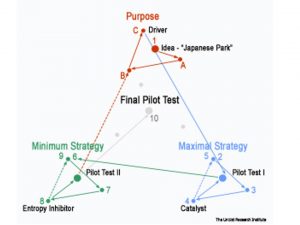Business Growth: The Unicist Critical Mass Method
The Unicist Critical Mass Method (UCMM) is a strategic approach to define the processes established by the business architecture in a way that ensures the results to be achieved.
 The Unicist Logical Approach requires the use of critical masses in the adaptive business processes. A Unicist Critical Mass is the smallest amount of force that is needed to generate the integration of the elements of the unified field of a human complex adaptive system to produce results.
The Unicist Logical Approach requires the use of critical masses in the adaptive business processes. A Unicist Critical Mass is the smallest amount of force that is needed to generate the integration of the elements of the unified field of a human complex adaptive system to produce results.
The Unicist Critical Mass Method (UCMM) is a design process that allows integrating the business architecture with the necessary synchronicity to be able to have a critical mass to add value and take advantage of opportunities. It requires a natural object driven organization with an adequate quality assurance process.
The quality assurance process that is included in the Unicist Critical Mass Method is based on having secure knowledge, on the use of destructive and non-destructive pilot tests to define the limits and validity of the solutions and on the existence of plans A, B, C and D to ensure results.
The Method
The UCMM follows the taxonomy and the ontological algorithm of the ontogenetic maps that correspond to the function of a business unit or process. The taxonomy defines the integration of the objects or concepts that are included and the ontological algorithm defines the process.
 The problem of using this method is that it is a strategic method, with strict hierarchical and relational rules to be applied but where the components are adaptive systems in themselves, like business objects, that need to be considered as having open boundaries and interdependent elements.
The problem of using this method is that it is a strategic method, with strict hierarchical and relational rules to be applied but where the components are adaptive systems in themselves, like business objects, that need to be considered as having open boundaries and interdependent elements.
Strategic methods need to be apprehended as a unified field having a positive solution thinking mind. If we take a look at the abstract ontological structure of an ontogenetic map, it can be seen that there are three pilot tests and a previous launching evaluation in any adaptive system.
The idea of a concept (see 1 in graph) is the starting point that opens the possibilities of an individual to participate in the use of the UCMM.
Everything starts with a very simple and transparent approach to reality where the idea is installed in an ambiguous way and those who participate start working with it according to their own perception of reality.
Critical mass implies integrating the elements that are part of a unified field and this has to happen in a hierarchical order and a relational conjunction.
The hierarchical order follows the evolution law and the relational conjunction implies that the distance of the events has to be according to the necessary timing to generate a synchronicity of the elements to work as a unit to produce results.
 Every event of the process of the UCMM has two schedules that have to be followed. Without following them there is no possibility of achieving a critical mass.
Every event of the process of the UCMM has two schedules that have to be followed. Without following them there is no possibility of achieving a critical mass.
For each event to be synchronic within the whole process it has to take place within a framework of time, no sooner than the earliest implementation time, and no later than the latest implementation time. Outside this timeframe the event lacks synchronicity and is therefore dysfunctional for the creation of a critical mass to produce a result.
Paradoxically, while each event needs to work as a unit within the system, having its own force, this means that it needs to be autonomous, and be able to work as an independent unit, at the same time, each event is required to work interdependently to produce a unique integrated result.
Peter Belohlavek
NOTE: The Unicist Research Institute was the pioneer in using the unicist logical approach in complexity science research and became a private global decentralized leading research organization in the field of human adaptive systems. It has an academic arm and a business arm.
https://www.unicist.net/conceptual-design/wp-content/uploads/2016/01/turi.pdf
